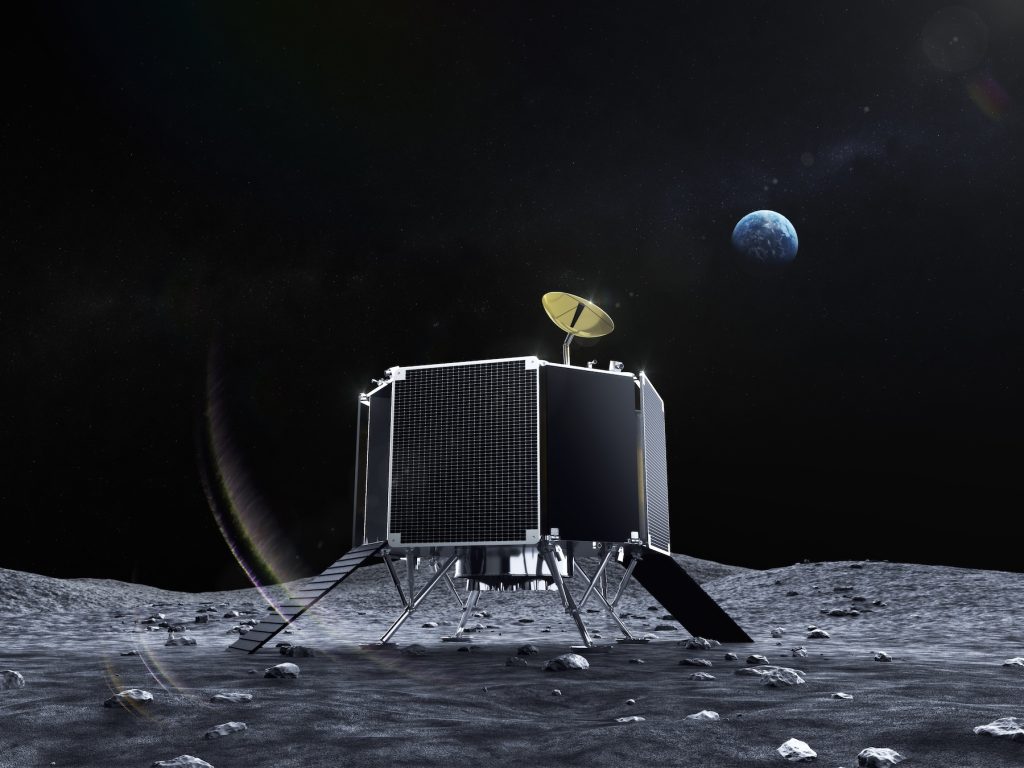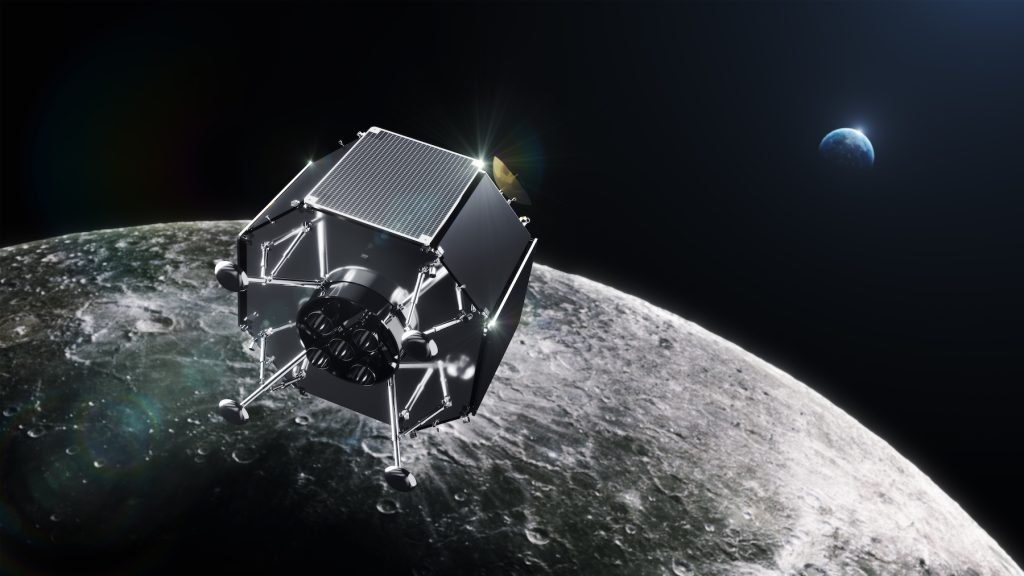24 Aug, 2021
The lander, larger in size and payload design capacity, is planned to be designed and manufactured in the US
Colorado Springs – Today, ispace, inc. (ispace) unveiled its next generation lunar lander, Series 2, which the company plans to first use for its third lunar mission (Mission 3), as well as subsequent future missions. Standing at approximately 11.5 ft tall and 14 ft wide (approx. 3.5 m tall by 4.2 m wide), including its legs, it is larger in both size and customer payload design capacity than ispace’s first-generation lander model, Series 1, which the company is developing for its first and second missions.

Targeting a launch date in the first half of 2024[i], Series 2 will be the largest and most capable lander ispace has developed. The plan is for it to be designed, manufactured, and launched in the United States. This past June, the lander already successfully passed a preliminary design review (PDR), a key development phase in the engineering of the vehicle. Moving forward, it is planned to be developed in partnership with General Atomics Electromagnetic Systems Group (GA-EMS) and Draper, forming a team with decades of heritage and success in space exploration.
Series 2 is designed to deliver payloads to both lunar orbit and the lunar surface. The lander has a payload design capacity to deliver up to 500kg[ii]to the lunar surface. For missions where payloads are exclusively for lunar orbit, capacity can be substituted to deliver up to 2,000kg[iii] to orbit. It has a modular payload design with multiple payload bays, allowing for flexibility and optimization for a wider range of government, commercial and scientific customers. Notably, the lander aims to be one of the first commercial lunar landers capable of surviving the lunar night and is designed to have the ability to land on either the near side or far side of the Moon, including polar regions.
Additionally, the lander’s Guidance, Navigation and Control (GNC) includes precision landing technologies capable of ensuring extraordinary accuracy during descent, including surface relative velocimetry and hazard avoidance enabling high-precision obstacle avoidance and pinpoint landing site targeting. The GNC technology is being provided to the Series 2 lander by Draper, which is recognized as a global leader in entry, descent and landing (EDL) capabilities with decades of experience dating back to the Apollo Program.

Series 2 is designed to offer a highly reliable solution for a diversity of missions, including potential future missions under NASA’s Commercial Lunar Payload Services (CLPS) program. Its propulsion system will use 5 pressure-fed main engines and 12 reaction control thrusters designed to maintain proper orientation throughout each mission and is equipped with an engine-out capability to ensure payload delivery even in the event of an engine loss, reducing risk and increasing probability of mission success.
The unveiling, which took place at the 36th Space Symposium in Colorado Springs, was attended by ispace Founder & CEO, Takeshi Hakamada; ispace US CEO, Kyle Acierno; and ispace U.S. Lander Program Director, Kursten O’Neill, who leads engineering for the Series 2 lander. The first hire at ispace US, Kursten joined ispace following seven years at SpaceX, where she managed new product introduction for the rocket manufacturer’s fleet of Falcon vehicles.
Comments
● Takeshi Hakamada, Founder & CEO, ispace: “As we look to the near future, Series 2 will enable us to not only increase our capabilities, but also to provide greater access and opportunities for our customers. Series 2 is a positive step toward realizing a diverse and sustainable cislunar ecosystem.”
● Kyle Acierno, CEO, ispace US: “I believe Denver is becoming the lunar lander capital of the world and we are proud to call it home! I’m grateful for the hard work and dedication from the team, as well as strong support from our partners, the local community and friends across the US, and the world. Over the next few months, we will work closely with Draper and General Atomics to prepare for the next NASA CLPS task order. With nearly 30 team members strong, we continue to grow in the U.S. and are focused on broadening our collaboration with American partners.”
● Kursten O’Neill, U.S. Lander Program Director, ispace: “I couldn’t be prouder of our team for what we have accomplished with this lander. We’ve successfully completed PDR and believe this vehicle will truly be a game changer. Due to its ability to adapt to a wide range of customers, after its debut for our third mission, we expect the Series 2 lander to service the market for several years and several missions to come.”
In addition to revealing the new lander model, ispace released a snapshot of its Payload User’s Guide for Series 2 and Mission 3. While a snapshot version of the document was released publicly, the complete Payload User’s Guide is available upon request.
ispace is currently making strong progress on its Mission 1 and Mission 2 preparations. The Series 1 lander for Mission 1 has completed key tests and is currently undergoing final assembly of its flight model at an ArianeGroup facility in Germany, ahead of its launch scheduled in the second half of 2022[iv]. The lander for Mission 1 expects to have a full customer payload manifest, including from the Mohammed bin Rashid Space Centre (MBRSC), The Japan Aerospace Exploration Agency (JAXA), and various commercial payloads[v]. Payload capacity is still available for customers to utilize on ispace’s Mission 2 lander and several discussions for transportation services are actively ongoing.
ispace, inc. (https://ispace-inc.com/)
ispace is a lunar exploration company with over 150 staff and offices in Japan, Europe and the United States. The company has raised a total cumulative funding of approximately $195.5 million (USD)[vi]. The funding is being used to build small commercial lunar landers, aiming to provide a high-frequency, low-cost delivery service to the Moon. Aspiring to be a gateway for private sector companies to bring their business to the Moon, ispace has also launched a lunar data business concept to support companies with lunar market entry. The company’s first lunar mission is planned for 2022[vii] with a second mission planned for 2023[viii]. On its first mission, ispace’s lander will deliver payloads for the Mohammed bin Rashid Space Centre (MBRSC), The Japan Aerospace Exploration Agency (JAXA), and three companies that received awards as part of the Canadian Space Agency’s (CSA) Lunar Exploration Accelerator Program (LEAP) program. The lander for the first mission is currently undergoing final assembly at an ArianeGroup facility in Germany and will launch from the United States on a SpaceX Falcon 9 rocket. ispace is also part of a team led by Draper, which was selected by NASA to compete in its Commercial Lunar Payload Services (CLPS) Program. Both ispace, inc. and ispace EU were awarded contracts to collect and transfer ownership of lunar regolith to NASA.
ispace technologies, U.S. (https://ispace-inc.com/us/)
Located in Denver, Colorado, ispace US is a subsidiary of ispace, inc. The office, which opened in late 2020, has nearly 30 employees and is rapidly growing. It serves as the central location for development of ispace’s Series 2 lander, as well as the central location for operations in North America. ispace’s plans to invest and develop robust operations in the U.S. is driven by its objective to partner with The National Aeronautics and Space Administration (NASA) to further its lunar exploration objectives, such as through the Commercial Lunar Payload Services (CLPS) program, and other business opportunities. ispace is currently involved in a strategic partnership with the Massachusetts-based R&D non-profit, Draper, as part of “Team Draper” to compete in the CLPS program; through this collaboration, ispace would assume the role as a subcontractor and design agent to Draper.
###
[i] Current plan as of August 2021.
[ii] Commercial payload sales mass and revenue will be mission dependent.
[iii] Commercial payload sales mass and revenue will be mission dependent.
[iv] Current plan as of August 2021.
[v] ispace is in the process of finalizing contracts to provide payload delivery services for certain customers.
[vi] Actual figure is JPY 21.3 billion; JPY to USD conversion provided for reference purposes, using the applicable FX rates as of the time of each funding.
[vii] Current plan as of August 2021.
[viii] Current plan as of August 2021.